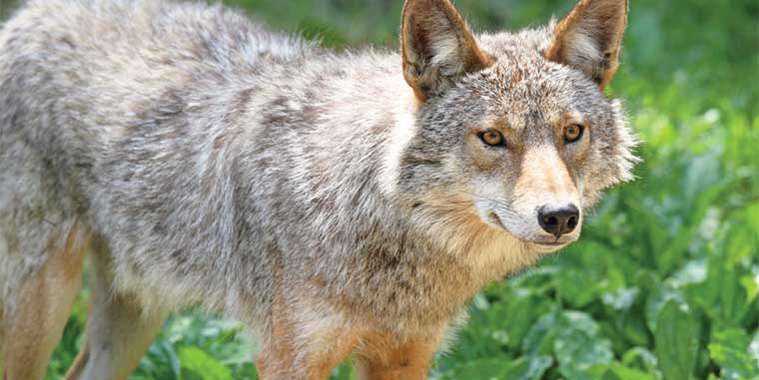By Dorothy Dobbie
In the past few years, Winnipeg has seen an increase in coyote traffic as these determined little members of the doggie family adjust to encroaching populations. Some residents have expressed concern over this invasion, but coyotes are not particularly interested in people, although they are braver in packs. If you encounter one, yell, stomp, throw something, look menacing. They will run away at speeds of up to 40 miles per hour (60 kmh). Nevertheless, you might want to keep your pets indoors at night, when coyotes are out and about looking for dinner.
The common coyote, Canis latrans, is among the most successful large mammals when it comes to coping with human expansion. There are now more coyotes than ever before and their range is expanding. They have spread northward in Canada to previously unpopulated areas such as Newfoundland and as far north as Flin Flon.
Once known as solitary animals for most of the year, coyotes would get together to form packs of three or four in fall to hunt. Pairs come back together to mate in March and to raise the young over the summer. Now, where small animal prey may have waned, especially around cities and towns, coyotes are more frequently seen hunting in groups to go after larger animals such as deer.
You might have seen coyote footprints in the snow and thought they were made by the neighbour’s dog. The footprints are similar, but look at the front toes. The claws of the dog’s two centre toes will point outward or perhaps straight ahead. The claws of the coyote’s toes point inward toward each other. The middle pad of a coyote has a centre lobe. The dog’s middle pad is shaped more like a triangle with no lobe at the bottom. (Cat feet don’t leave claw prints.)
The urban coyote is a family guy. He falls in love for life — a life that lasts 10 to 12 years — and never cheats. A study conducted by Ohio State University looked at 236 coyotes over six years and found no evidence of polygamy. It is still a mystery, given this hypotheses, how coyotes sometimes mate with dogs —and they do.
Family groups occasionally get back together, the pups visiting the parents from time to time. Often, a coyote pack will consist of an alpha pair – the parents – and three to eight additional family members. The parents in the pack are the only ones that mate and females from previous litters will often help mom bring up the siblings. Females can produce anywhere from three to 12 offspring at a time.
Coyotes are well known for their lonely-sounding howl, but in fact, they have many other vocalizations, among them yips, growls, huffs, woofs, barks, whines, yelps, whoops, yodels and group howls, where they sing together. Whistles and sirens will often set off a coyote howl. Howls can be heard from as far as one kilometer if there is nothing obstructive in the way. The vocalizations are aided by very eloquent body language.
Coyote are among the most intelligent of wild animals. This is one reason they have been able to adapt so well to the spread of humankind. They exhibit all sorts of interesting behaviour to demonstrate this. A northern Ontario resident captured a video of a wild coyote playing with a ball. The coyote would carry the ball up a hill, watch it roll down, give the ball a head start, then chase it. It did this three times on the video. https://www.youtube.com/watch?v=daTwwUJLUsY Coyotes have been observed tossing snow at a spring-trap until it triggers, then stealing the food from the trap. Apparently, they can hear a hunter approaching from about five km away. Nevertheless, Manitoba coyote fur trappers bag up to 8,000 of the critters for their fur every year.
Will coyotes eat your pets? A study of the scat of a group of urban coyotes turned up the following results: 42 percent of their diet consisted of small rodents; 23 per cent was fruit; 18 per cent was rabbits; 2 per cent was human garbage and 1.3 percent turned out to be cats. Coyotes also eat geese eggs. Having a coyote in the neighbourhood is considered proof of a healthy eco system.
By the way, is the proper pronunciation of coyote ky-oat . . .or ky-oat-ee or even ky-oot? I’d say it’s a matter of choice, depending on where you are from in Canada. Here in the prairies, we usually say ky-oat, but the extra syllable pops up more and more often. And if you are from the farm, chances are you say ky-oot! The word comes from the Aztec word coyotl, which the Spanish found hard to pronounce – so we are all wrong!
Dorothy Dobbie is the publisher of Manitoba Gardener.



